Greetings, everyone! New to the forum, but long time lurker and reenactor, as well as general historical weapons enthusiast.
My question to you is this: After spending a lot of time trawling through documents, images, drawings, etc, I've had no luck finding out what style of musket we see in the top center of this image ( the two guys at the edge of the woods), from the journal of Samuel de Champlain.
[ Linked Image ]
From what I've found so far, it doesn't seem to be the typical 17th century "fishtail" stock, but rather a butt with a downward slope, like this:
[ Linked Image ]
What are these guys carrying? I love this style stock, and am planning a new matchlock build, but want something that would be correct in the early 17th century in North America. Lots of other stuff I've read has indicated a LOT of these guns coming out of the Netherlands and Germany at that time, and likely would've been what was coming over to the New World with the French and Dutch.
Thoughts?
Dear John, I think that stock design is plausible for the period & place you are looking for. My understanding is that they were bit earlier than typical "fishtail" muskets. I´m attaching two scans which could be illustrative.
 Attachment: 97.69 KB
Attachment: 97.69 KB
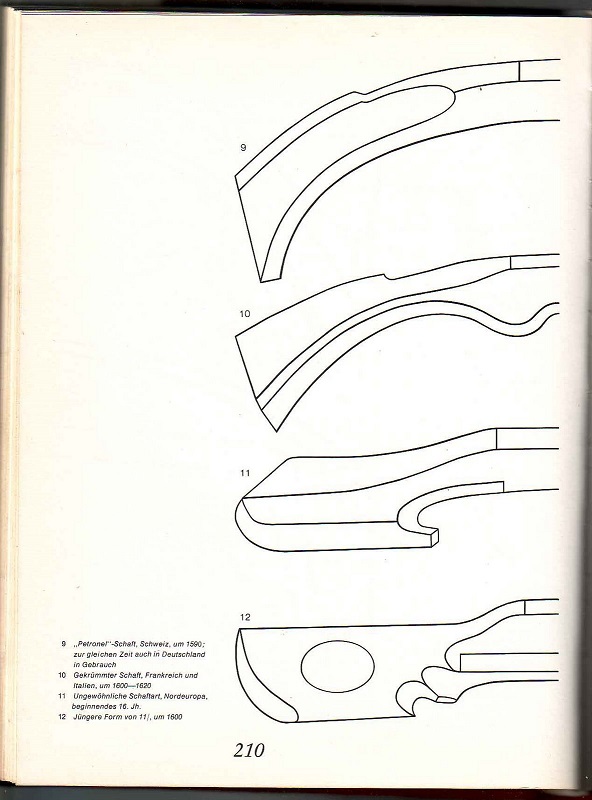
 Attachment: 105.19 KB
Attachment: 105.19 KB
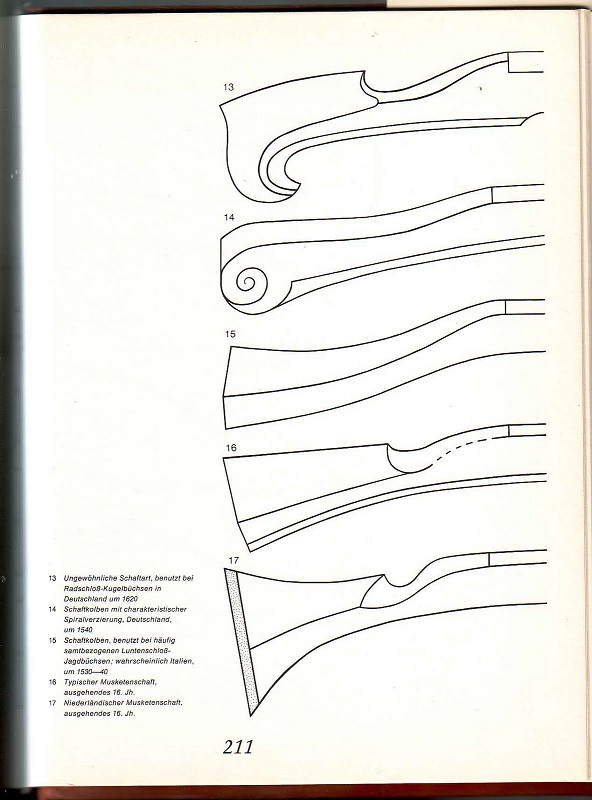


Going only from memory here: I believe the petronel was a lighter firearm compared to the musket. The design images mention the term, so I will guess that what we're seeing in the Champlain image are petronels. It's hard to tell, but it doesn't look like there are musket rests in use, which would suggest the lighter weapon.
Yes...see here: http://www.oocities.org/yosemite/campground/8551/firearms.html
The stock is meant to be braced on the chest.
The stock is meant to be braced on the chest.
LeMoyne shows similar weapons deployed in Florida explorations.
 Attachment: 114.87 KB
Attachment: 114.87 KB
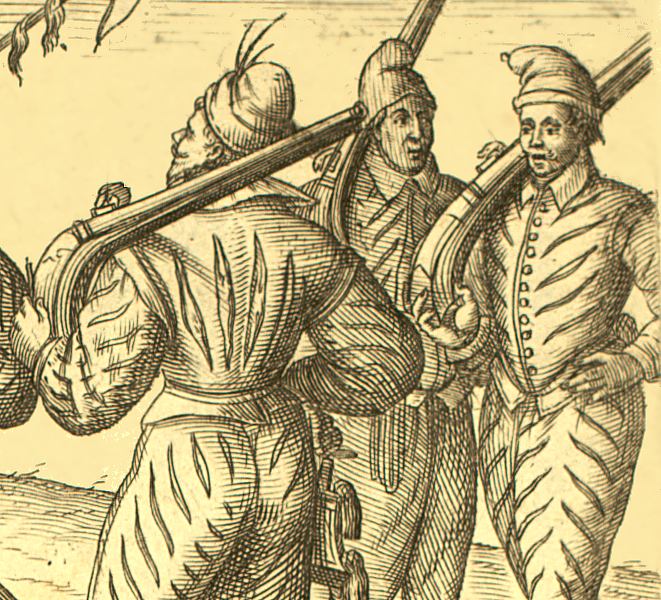
 Attachment: 163.43 KB
Attachment: 163.43 KB
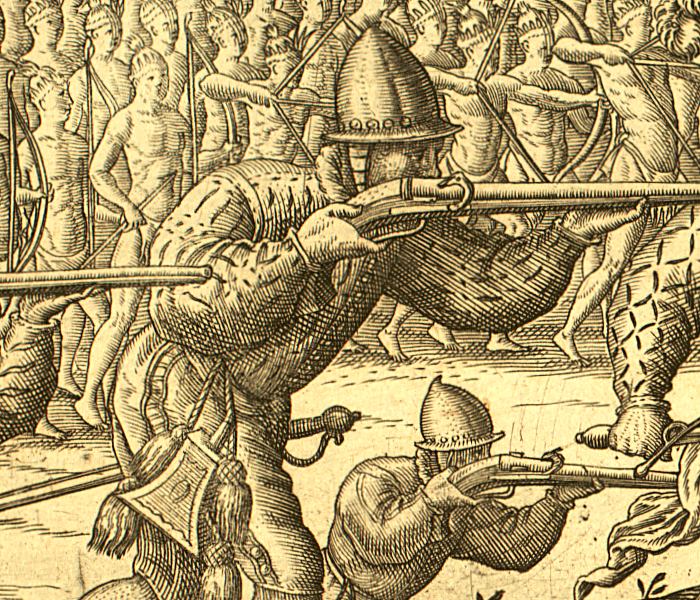


" I believe the petronel was a lighter firearm compared to the musket"
I´d say you are right Sean. Applying our terminology on historical weapons could be problematic, but I´d say this holds. When you look at the period artwork I can see that "petronels" (or whatever you call that early firing weapon, with downward-curved stock) were fired without supporting rests (even when they were used alongside traditional muskets with rests), which would imply that they were lighter.
On the pictures I´ve seen, when firing, they´re held only in hands (the right hands holds the end of the stock in something like a pistol-grip, the left one supports the weapon around its center of gravity - that´s the case esp. on pictures from the first half of the 16th cent.), they could be braced on the chest (esp. those with strongly curved stocks), or held under the arm.
Lots of pictures of originals & period artwork in this thread on another forum: http://www.vikingsword.com/vb/showthread.php?...t=petronel
I´d say you are right Sean. Applying our terminology on historical weapons could be problematic, but I´d say this holds. When you look at the period artwork I can see that "petronels" (or whatever you call that early firing weapon, with downward-curved stock) were fired without supporting rests (even when they were used alongside traditional muskets with rests), which would imply that they were lighter.
On the pictures I´ve seen, when firing, they´re held only in hands (the right hands holds the end of the stock in something like a pistol-grip, the left one supports the weapon around its center of gravity - that´s the case esp. on pictures from the first half of the 16th cent.), they could be braced on the chest (esp. those with strongly curved stocks), or held under the arm.
Lots of pictures of originals & period artwork in this thread on another forum: http://www.vikingsword.com/vb/showthread.php?...t=petronel
Thanks for the replies!
To me, it looks like those guys are shooting something that's a bit longer than the typical "petronel" style (totally agree with the varying terms/definitions for this, though).
All terminology aside, and given what we know about lightening the very heavy musket around that time period, it makes sense to me that the guys coming over with Champlain would want something slimmer and lighter. The bottom image that I posted mentioned a 44" barrel, octagon to round, and in .70 caliber. Again, based on the images I'm seeing, this is congruent with the Champlain image and travelling and fighting in the wilderness of N. America.
Further thoughts? Am I just talking myself into a loop?
To me, it looks like those guys are shooting something that's a bit longer than the typical "petronel" style (totally agree with the varying terms/definitions for this, though).
All terminology aside, and given what we know about lightening the very heavy musket around that time period, it makes sense to me that the guys coming over with Champlain would want something slimmer and lighter. The bottom image that I posted mentioned a 44" barrel, octagon to round, and in .70 caliber. Again, based on the images I'm seeing, this is congruent with the Champlain image and travelling and fighting in the wilderness of N. America.
Further thoughts? Am I just talking myself into a loop?
Maybe, I´d consult a book from Carl Parcher Russell: Guns on the Early Frontiers: A History of Firearms from Colonial Times Through the Years of the Western Fur Trade (Uni of Nebraska Press, 1980). I´d found it when searching for some stats on early firearms - it´s partly available on Google Books: https://books.google.sk/books?id=KC7O5i7-O4UC&printsec=frontcover&hl=sk#v=onepage&q&f=false
On page 8 for example it describes firearms used by early French expeditions - they´re lighter, with smaller caliber (see the attachment). The books gives also some other examples.
However, I can´t say anything about the accuracy of the book, nor had I seen it in full: I went only briefly through what´s available online (had anyone seen it? is it good / informative / accurate?)
 Attachment: 61.6 KB
Attachment: 61.6 KB
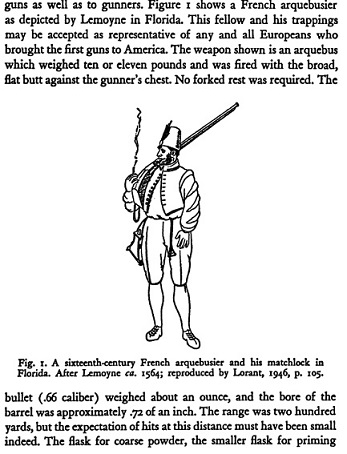
On page 8 for example it describes firearms used by early French expeditions - they´re lighter, with smaller caliber (see the attachment). The books gives also some other examples.
However, I can´t say anything about the accuracy of the book, nor had I seen it in full: I went only briefly through what´s available online (had anyone seen it? is it good / informative / accurate?)

Hi John,
I've just come across your post, having been perusing forums on matchlocks for my own interests. The photographs in your first post certainly do show petronels; the stock shape is characteristic of those made in the last years of the 16th century and therefore in keeping with your theory.
If you wish to read more on this type of weapon, I recommend the following :
http://www.vikingsword.com/vb/showthread.php?...t=Petronel
Written by a very knowledgeable historian by the name of Michael Trömner.
Best wishes,
Paul
I've just come across your post, having been perusing forums on matchlocks for my own interests. The photographs in your first post certainly do show petronels; the stock shape is characteristic of those made in the last years of the 16th century and therefore in keeping with your theory.
If you wish to read more on this type of weapon, I recommend the following :
http://www.vikingsword.com/vb/showthread.php?...t=Petronel
Written by a very knowledgeable historian by the name of Michael Trömner.
Best wishes,
Paul
Page 1 of 1
You cannot post new topics in this forumYou cannot reply to topics in this forum
You cannot edit your posts in this forum
You cannot delete your posts in this forum
You cannot vote in polls in this forum
You cannot attach files in this forum
You can download files in this forum
All contents © Copyright 2003-2006 myArmoury.com — All rights reserved
Discussion forums powered by phpBB © The phpBB Group
Switch to the Full-featured Version of the forum
Discussion forums powered by phpBB © The phpBB Group
Switch to the Full-featured Version of the forum